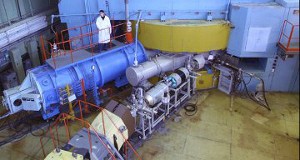The chemical element dubnium is classed as a transition metal. It was discovered in 1970 by a team of scientists led by Georgy Flerov.

Data Zone
| Classification: | Dubnium is a transition metal |
| Color: | |
| Atomic weight: | 268, no stable isotopes |
| State: | solid (presumed) |
| Melting point: | |
| Boiling point: | |
| Electrons: | 105 |
| Protons: | 105 |
| Neutrons in most abundant isotope: | 163 |
| Electron shells: | 2,8,18,32,32,11,2 |
| Electron configuration: | [Rn] 5f14 6d3 7s2 |
| Density @ 20oC: |
Reactions, Compounds, Radii, Conductivities
| Atomic volume: | – |
| Structure: | – |
| Hardness: | – |
| Specific heat capacity | – |
| Heat of fusion | – |
| Heat of atomization | – |
| Heat of vaporization | – |
| 1st ionization energy | – |
| 2nd ionization energy | – |
| 3rd ionization energy | – |
| Electron affinity | – |
| Minimum oxidation number | – |
| Min. common oxidation no. | – |
| Maximum oxidation number | – |
| Max. common oxidation no. | – |
| Electronegativity (Pauling Scale) | – |
| Polarizability volume | – |
| Reaction with air | – |
| Reaction with 15 M HNO3 | – |
| Reaction with 6 M HCl | – |
| Reaction with 6 M NaOH | – |
| Oxide(s) | – |
| Hydride(s) | – |
| Chloride(s) | – |
| Atomic radius | – |
| Ionic radius (1+ ion) | – |
| Ionic radius (2+ ion) | – |
| Ionic radius (3+ ion) | – |
| Ionic radius (1- ion) | – |
| Ionic radius (2- ion) | – |
| Ionic radius (3- ion) | – |
| Thermal conductivity | – |
| Electrical conductivity | – |
| Freezing/Melting point: | – |

Part of the heavy ion cyclotron U400 in Dubna, Russia. Image by Jim Roberto, Oak Ridge National Laboratory
Discovery of Dubnium
Credit for the discovery of dubnium is shared between teams of scientists at the Joint Institute for Nuclear Research at Dubna, Russia and scientists at Lawrence Berkeley National Laboratory, California.
In 1968, the team in Russia led by Georgy Flerov bombarded an americium-243 target with neon-22 ions and synthesized isotopes of element 105, identified as 260Db or 261Db. The experiment was repeated a year later using gradient thermochromatography for more precise identification of the isotopes formed. Synthesis of 260Db was confirmed in 1970.
The Dubna team proposed calling the new element neilsbohrium (Ns) after the Nobel Prize winning physicist Niels Bohr.
In 1970, the team in California led by Albert Ghiorsio also attempted to synthesize element 105. They had no success with repeating the Russian experiment but they successfully synthesized element 105 by bombarding a californium-249 target with nitrogen-15 ions.
They suggested the name hahnium (Ha) for the new element, after the Nobel Prize winning chemist Otto Hahn.
The Council of the International Union of Pure and Applied Chemistry (IUPAC) decided in 1997 that transactinide element 105 should be given the name Dubnium (Db) after the research facility in Russia where it was synthesized.
Appearance and Characteristics
Harmful effects:
Dubnium is harmful due to its radioactivity.
Characteristics:
Dubnium is a transactinide or super-heavy element.
It is a radioactive synthetic metal and has only been produced in tiny amounts.
Uses of Dubnium
Dubnium is of research interest only.
Abundance and Isotopes
Abundance earth’s crust: nil
Abundance solar system: parts per billion by weight, parts per trillion by moles
Cost, pure: $ per 100g
Cost, bulk: $ per 100g
Source: Dubnium is a synthetic radioactive metal, created by nuclear bombardment, and has only been produced in tiny amounts. Dubnium is made by bombarding californium-249 with nitrogen. It can also be produced by bombarding americium-243 with neon.
Isotopes: Dubnium has 12 isotopes whose half-lives are known, with mass numbers from 256 to 270. None are stable. The most stable isotope is 268Db, with a half-life of 32 hours.

References
Cite this Page
For online linking, please copy and paste one of the following:
<a href="https://www.chemicool.com/elements/dubnium.html">Dubnium</a>
or
<a href="https://www.chemicool.com/elements/dubnium.html">Dubnium Element Facts</a>
To cite this page in an academic document, please use the following MLA compliant citation:
"Dubnium." Chemicool Periodic Table. Chemicool.com. 18 Jun. 2015. Web. <https://www.chemicool.com/elements/dubnium.html>.
this is a great thing
Hi everyone, I was just wondering what the color of Dubnium is? please reply asap thank you